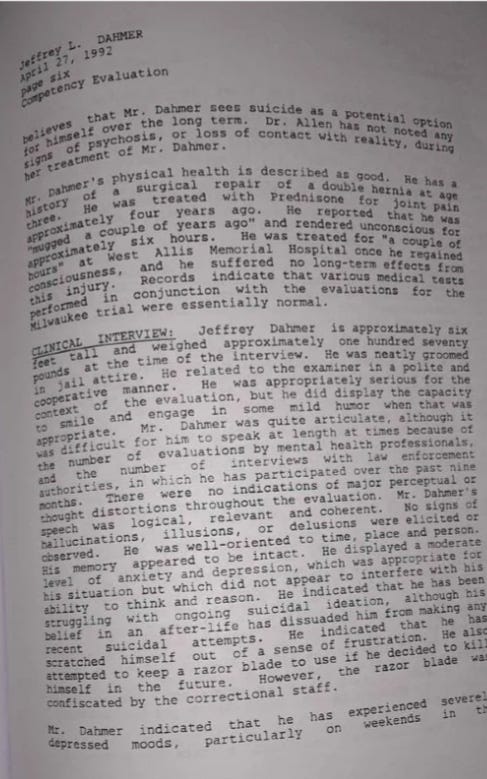Polymyositis: The Disease Behind Jeff Dahmer's Unusual Gait
This illness would have made the actions sensationalized by the media impossible for him to pursue.
Remember how Jeff Dahmer was portrayed in the Netflix series? The lead actor, Evan Peters, wore weights around his hands to capture Jeff's unique posture.
But, why was Jeff Dahmer’s posture like that?
A little-known, shocking truth is that Jeff Dahmer suffered from polymyositis, a debilitating condition. As you will see, this illness would have made the actions sensationalized by the media impossible for him to pursue. Even minor activities, such as walking or lifting objects, would have been challenging for him at times.
The media concealed this vital information, and Jeff Dahmer’s lawyer, Gerald Boyle, did not present it during the trial. Keep reading to find out why.
What is Polymyositis?
Polymyositis is a rare autoimmune disease that causes inflammation and muscle weakness. It can affect any muscle in the body, including those responsible for breathing and swallowing.
Evidence indicates that Jeff Dahmer was diagnosed with this condition in 1988 and was undergoing treatment at the time of his reported arrest in 1991. He even had to use a wheelchair on occasion due to his weakened state.
Uncovering Jeff Dahmer's Secret Illness
During his court testimony, Dr. Fosdal revealed that Jeff used steroids for about a year to address a shoulder issue.
Here's an excerpt from the collection of reports by psychiatrists who interacted with and examined Jeff. This collection, titled Psych Reports, details Jeff's condition. In the final paragraph, it mentions that Jeff suffered from polymyositis and was on Prednisone for a year:
The passage states that Jeff Dahmer…
Had polymyositis for about one year - shoulder - was on Prednisone, 1 tablet a day for one year.
Reliable medical sources provide detailed descriptions of this disease online. Here's an example from Johns Hopkins:
Polymyositis is an autoimmune disease in which striated muscle become inflamed. The reason for going to the doctor is usually increasing weakness in the muscles of the arms, legs, neck and back. As a rule, the first symptoms of polymyositis are nonspecific and often occur in other diseases: fatigue, weakness, malaise, weight loss*, alternating pain in different muscles, fever.* Sometimes there is pain and swelling in the joints**, after which it becomes harder to bend and unbend them.**
Over the course of several weeks or months, weakness in the muscles of the arms and legs gradually increases. If we are talking about shoulder polymyositis, it becomes impossible to raise your arms above the head. High doses of steroid hormones are used to treat polymyositis. It is important to start treatment as early as possible, preferably within the first three months of the onset of symptoms. There's no cure for polymyositis, but the symptoms can be managed.
What are the symptoms of polymyositis?
More from Johns Hopkins:
The condition affects muscles all over the body and can affect the ability to run, walk, or lift objects. It can also affect the muscles that allow you to eat and breathe. The muscles that are closest to the center of the body tend to be affected the most often.
The common symptoms of polymyositis include:
Muscle pain and stiffness
Muscle weakness, particularly in the belly (abdomen), shoulders, upper arms, and hips
Joint pain and stiffness
Trouble catching your breath
Problems with swallowing
Irregular heart rhythms, if the heart muscle becomes inflamed
Polymyositis can make it hard to do everyday things. You may notice trouble walking up a flight of stairs, lifting up your arms, or getting out of your chair. As inflammation gets worse around the body, pain and weakness may affect the ankles, wrists, and lower arm area.
Weight loss and poor nutrition may become a problem if muscle weakness leads to trouble eating and swallowing.
What are possible complications of polymyositis?
If polymyositis is not treated, it can lead to severe complications. As the muscles become weaker, you may fall often and be limited in your daily activities. If the muscles in the digestive tract and chest wall are affected, you may have problems breathing (respiratory failure), malnutrition, and weight loss. Polymyositis that is treated but can't be managed well can cause severe disability. It can lead to an inability to swallow or breathe without help.
The reason behind the claim that Jeff had polymyositis for "about one year" remains a mystery. Polymyositis is incurable. However, with proper care, vitamins, and regular doctor visits, remission is achievable. The correct treatment and care can help manage symptoms and improve quality of life. In addition to medication, physical therapy is crucial in maintaining muscle strength and mobility for patients with this condition.
Here's a Halcion prescription for Jeff, which was hidden during the so-called trial. It was written by Dr. Bruce S. Hong, a rheumatologist. Rheumatology is a medical specialty that focuses on the diagnosis and treatment of diseases and disorders related to the joints, muscles, bones, and immune system. This includes conditions such as arthritis, lupus, fibromyalgia, and polymyositis.
Given Jeff's condition, it makes sense that he would seek treatment from a rheumatologist.
Here's another excerpt from the report prepared for the Ohio trial by clinical psychologist Kathleen P. Stafford on April 27, 1992.
The second paragraph notes that Jeff was treated with Prednisone, a steroid, for "joint pain" approximately four years ago (in 1988), but it does not mention polymyositis. However, in some instances, polymyositis can spread to the joints and cause pain:
Now it’s clear why Jeff Dahmer walked the way he did. His frail shoulders and rigid posture were unmistakable clues to his hidden condition. Televised court footage vividly captures him struggling to rise from his chair, indicative of polymyositis as mentioned in the example above. You can view video evidence of this on YouTube.
This also sheds light on his noticeable weight loss and why he appeared so thin during his first court appearance (illustrated in the image below). Such physical symptoms were not just mere coincidences but were reflective of the debilitating nature of his disease, which affected him long before his reported arrest.
Jeff's subsequent rapid weight gain after the arrest can be attributed to a more intense course of steroid treatment prescribed by his doctors to manage his medical condition. This weight gain was not due to the "prison food" as the media suggests, but rather a necessary aspect of his ongoing health regimen. The steroids, while effective in treating his condition, would have had the side effect of significant weight gain.
It should be noted that Prednisone can also cause a redistribution of fat to the face, back of the neck, and the abdomen, although these changes vary from person to person. Generally speaking, the higher the dose and the longer the treatment, the greater the changes. Prednisone may also interrupt the patient's sleep cycle, leading to the disruption of the hormones that regulate appetite.
Here is a widely available online image of Jeff in a wheelchair. Contrary to media reports claiming that the "heavy shackles" on his ankles made walking impossible, this assertion is false. In fact, there is ample footage showing him walking freely.
The reality is that Jeff occasionally needed wheelchair assistance due to his struggle with polymyositis. Due to the mobility challenges posed by this condition, a wheelchair may be necessary for extended distances or during flare-ups.
In Lionel Dahmer's book A Father's Story, it is detailed that vitamins, proteins, and calcium were found in Jeff's apartment—an unusual assortment for a ''necrophiliac serial killer'' allegedly fixated on his next victim. However, these items are perfectly normal for someone who prioritizes their health. Notably, calcium is significant because steroid treatments can cause calcium depletion, potentially leading to osteoporosis. Interestingly, acne lotion was also found in his apartment, suggesting that it might be a side effect of his steroid treatment.
Several questions arise:
When was Jeff first diagnosed with polymyositis? Was it in 1988?
Could this diagnosis have been prompted by the stress of his "arrest" for the alleged molestation of Somsack Sinthasomphone at an apartment associated with District Attorney E. Michael McCann? (see our article The District Attorney Michael McCann)
Why is Jeff's polymyositis such a well-kept secret? This critical detail appears only in Dr. Fosdal's testimony and Kathleen P. Stafford's report, both of which are buried in obscurity. The media and the trial intentionally hid this crucial medical context, fully aware that exposing it would completely shatter the false narrative.
How on earth was Jeff Dahmer able to drag the bodies of grown men around his apartment and dismember them, all while suffering from polymyositis?
Additionally, steroids can lower immunity, putting people at a higher risk of infections. Treatment with these drugs weakens the immune system, making the body more susceptible to fungal, bacterial, viral, or parasitic infections that can lead to serious illness. Yet, we’re told that Jeff managed to chop up dead bodies in his tiny apartment, facing numerous bio-hazards without ever getting sick.
Doesn't that sound absurd?
In a real-life scenario, a cross-examination during the preliminary hearing—something Jeff never got—would have revealed that his condition made it impossible for him to commit these acts. It would have also exposed the glaring inconsistencies in his confession, such as the fact that it contained another man's social security number. A prudent judge, acknowledging the absence of probable cause, would have promptly dismissed the charges.
The reality is that Jeff Dahmer couldn’t possibly have done what the sensationalized media reported. The story of the ''Milwaukee Cannibal'' was a myth all along. The gruesome tales that captivated public imagination and fear were fabricated and exaggerated, feeding into a narrative that obscured the truth. Exploring the real events reveals a much more complex and less sensational story than the one that dominated headlines.
What do you think about how the media has portrayed Jeff in light of this recent discovery? The fact that this crucial medical context was obscured from the public is deeply troubling. It suggests a willful attempt to perpetuate the false narrative and deny the humanity of an individual with a disability.
In conclusion, Jeff Dahmer's battle with debilitating polymyositis adds another layer to this case and raises important questions about the accuracy of media portrayals. The truth is often more complex than the stories we are fed, and it is important to question and critically analyze information before accepting it as fact.












Poor Jeff. It must have been debilitating indeed. The portrayal of him is very cruel. Stress can indeed bring on such conditions too.
As always, good job author. I also used to wonder why is Jeff always slouching. I had this doubt all along and when I read your articles, that all made sense then. It's all a freaking stupid myth that he was a Milwaukee Cannibal. Poor Jeff :((